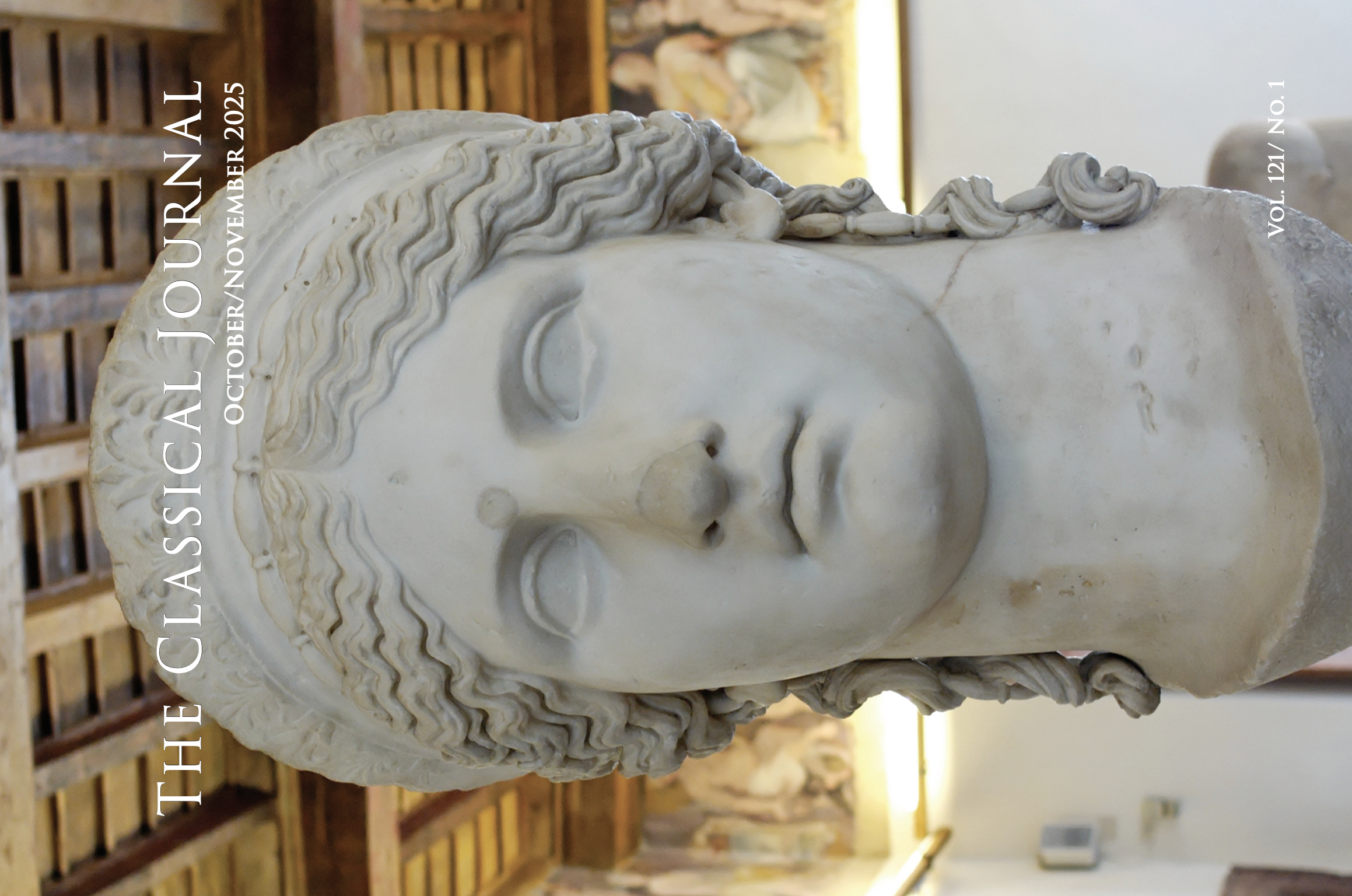The following articles are contained in CJ
115.3/4
Abstracts of Articles
DEORUM BENEFICIO REI PUBLICAE PROCREATUS: CICERO’S PANEGYRICAL PORTRAIT OF OCTAVIANUS
Cicero’s persuasive goal in his Philippics was to rouse the senate and people of Rome to resist Marcus Antonius in hopes of restoring the libertas populi Romani and some semblance of the Republic as he envisioned it. As is the case in all of Cicero’s oratory, the presentation of character plays a crucial role in the persuasive process. The orator’s portrait of young Caesar Octavianus, crucial to his strategy, is rooted in elements of laudatory oratory, borrowed largely from his earlier panegyrical depictions of Pompeius Magnus and Julius Caesar. This portrait of praise, drawn throughout the Philippics, proved not only persuasive to the senate, but also influential on Octavianus himself, who later as Augustus employed several of its elements when recounting his own accomplishments.
HORACE’S “ROMAN ODES”
It is argued (a) that the title “Roman Odes” is a misnomer and should be replaced, (b) that the six odes do not constitute one long, single poem, as has recently been suggested.
THE KINGS OF THE LAURENTES: CONTRADICTIONS AND POINTS OF VIEW IN VIRGIL’S AENEID
The genealogy of the kings of the Laurentes given by the narrator at Aen. 7.45–9 (Saturn–Picus–Faunus–Latinus) is at odds with the one suggested by the description of the statues of Picus’ palace at 7.177–91, where we find the sequence Italus–Sabinus–Saturn–Janus–Picus. Both genealogies are then contradicted by Evander’s account of the history of Latium at 8.313–36. These irreconcilable versions reflect the different political and cultural interests of the different characters involved (the “Varronian” narrator, the kings of the Laurentes themselves and King Evander).
SACRIFICIAL ACROSTICS AND THE FALL OF GREAT CITIES IN VIRGIL AND LUCAN
This note argues that an intertextual acrostic conversation spanning key passages in Virgil and Lucan draws a connection between the fall of Troy, depicted as a sacrifice, and the “fall” of Rome in its civil war. A long vertical utterance, spanning the lines in which the gods destroy Troy, simultaneously admonishes the city to be sacrificed and Aeneas to leave it behind (Aen. 2.614–28). Lucan echoes this acrostic in lines whose horizontal text transitions from fulsome flattery of Nero to the reasons for Rome’s doom (BC 1.62–70), simultaneously hinting at the necessity for “sacrificing” the emperor and questioning the theology underpinning his own poem.
PATTERNS OF PRAYER IN OVID’S METAMORPHOSES AND THE SUPPRESSED RAPE OF LAVINIA
Although the story of Anius’ daughters in Ovid’s Metamorphoses (13.640–74) lacks explicit erotic elements, it evokes an erotic context through allusion to entreaties made in previous scenes of attempted rape. In the first third of Ovid’s epic, prayers for divine assistance are an essential, repeated component in stories of attempted rape. The plea by Anius’ daughters in Book 13 recalls the petitions in these scenes. This reference in turn activates an alternative tradition about the daughters of Anius, known through Servius, in which Aeneas rapes a daughter of Anius named Lavinia (Serv. Dan. Aen. 3.80). Recognizing an echo of the pattern of prayer and attempted rape bolsters Casali’s idea that Ovid acts as both a corrector of Vergil and draws attention to an alternative, more dubious Aeneas. Ovid simultaneously suppresses Lavinia’s rape in his own narrative and points to Vergil’s censorship of the story in Book 3 of the Aeneid, thereby positioning himself as a critical reader of the Aeneid and Rome’s problematic “foundation in raped female bodies.”
OVIDIAN SYNCHRONISMS
Recent research has emphasized Ovid’s attention to the conventions of historiography and mythography, especially in the Metamorphoses and the Fasti. These conventions include the trope of synchronism, which is common to several genres of history and mythography. Ovid’s use of synchronism as a transitional device in the Metamorphoses, censured by critics since Quintilian, has recently been defended by Thomas Cole, who argues that these synchronisms are not merely indices of Ovid’s indulging his own cleverness, but also proof of his determination to preserve chronological decorum in the poem’s structure. This challenges the idea that Ovid subverts virtually all forms of authoritative organization, including those involving time. While broadly persuasive, Cole’s intervention does not address the tendency of synchronisms to attract a significance that exceeds what is necessary to maintain a coherent chronological framework. In this paper, I defend this claim by discussing some of the early, programmatic synchronisms of the Metamorphoses and some broadly similar passages.
FORMA MANET FACTI (OV. FAST. 2.379): AETIOLOGIES OF MYTH AND RITUAL IN OVID’S FASTI AND METAMORPHOSES
Beginning with an understudied variety of aetiology in the Fasti—the “contingent” aetiology—this paper argues that Ovid exploits the Roman tradition of multiple aetiology in order to explore important aspects of the relationship between the present and the past. The paper concludes by examining the great differences between the Fasti and the Metamorphoses in their treatments of aetiology, change and continuity.
OVID’S ARISTAEUS (FAST. 1.363–80)
John Miller has helped illuminate the sophistication of Ovid’s didactic approach in the Fasti by showing that even in aetiological variants for a festival’s etymology, in this case the Agonalia, a playful and refined Callimacheanism is at work. This paper follows up on his insight by examining further examples of Ovid’s intertextual engagement in the Agonalia, including, notably, with his own Metamorphoses and with Virgil’s Aristaeus epyllion at the end of the Georgics. Allusion for Ovid acts as a rhetorical tool for critical, authorial intervention into the Virgilian and didactic tradition.
CARMENTIS AND THE POET: DEIFICATION AND EXILE IN OVID’S FASTI
In Fasti 1, the festival dedicated to Carmentis, a prophetess (vates) named after carmen, “song” itself, has strong programmatic implications for Ovid’s own song and his vatic persona. Harking back to Aeneid 8, where Carmentis is mentioned in passing, Ovid presents her in a new light: as a vates of exile and deification. Carmentis both prophesies and prefigures what will become an entire chain of deifications of members of the house of Augustus, and she is deified herself. She strikingly contrasts with the poet Ovid, who will not receive similar honors. Instead, his own fate is mirrored in Carmentis’ first speech, on the topic of exile. We can recognize a ring structure with strong closural force: the prophecies of the very first vates, Carmentis, foreshadow the birth of “gods” that were so powerful that they could send Ovid into exile and silence Rome’s most recent vates. Ovid’s exile thus becomes more than a personal mishap. It marks the completion of a circle of events that began once the first vates set her foot on Italian soil.
DIVINE JOURNEYS: GEOGRAPHICAL CATALOGUES IN OVID’S FASTI 4
This paper examines the geographical catalogues that describe the journeys of the goddesses Cybele and Ceres in Fasti 4. Looking beyond their narratological function as transitional devices and as displays of erudition, it seeks also to show how geography intersects with and further illustrates the poem’s interest in religious innovation, generic experimentation and imperial expansion. The journeys of the two goddesses, which are notable as the only geographical catalogues of the poem, provide imaginary maps of both the previous literary tradition and of the Roman empire.
NAMING JUNE: CULT, INTERTEXTUAL COMPETITION AND AUGUSTAN POLITICS IN OVID’S FASTI 6
The sixth and final book of Ovid’s Fasti begins with an argument over the origin of the name of June. Three goddesses—Juno, Juventas and Concordia—claim to be the source of the name. The whole competition is framed as a repeat of the judgment of Paris, and Ovid finally declines to make a choice. The result of the original judgment of Paris is the Trojan War, a legend inextricably connected to the narrative of Rome’s own foundation. Thus all three claimants for the name rely on the narrative of history brought about—in poetic terms—by the fall of Troy. In refusing to pass judgment, Ovid prevents a second Trojan War and does not take the decisive step that authorizes any of the contending narratives and brings about Augustan Rome. In refusing to settle the origin of June’s name, Ovid stops the calendar from moving on to July and August, the months named for the founders of the Julio-Claudian dynasty. Thus, Ovid ends his calendar by calling into question the Augustan future, one that had not yet been written.
BACCHUS, HERCULES AND LITERARY HISTORY IN STATIUS’ ACHILLEID
Epic characters often reflect attributes of the gods, and in Statius’ Achilleid, Achilles is no different. At various moments in the poem, he is similar to Jupiter, Apollo and Bacchus. This paper develops the connections between Achilles and Bacchus by arguing for the importance of the dramatic representation of Bacchus—and that of his brother Hercules—to understanding the larger plot of Statius’ poem. Achilles’ behavior recalls in particular the comic presentations of Bacchus and Hercules as figures who can transgress normal bounds without compromising their elevated status. Moreover, the comic Bacchus and Hercules afford models for the coexistence of seemingly paradoxical or even contradictory attributes within a character. While Achilles’ literary heritage is undoubtedly part of the Homeric tradition, Statius also draws upon other genres and artistic strategies for his treatment of the hero.


